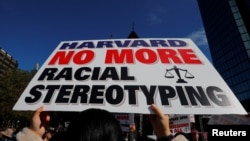Student Union
Diversity Among Asians Divides Them on Affirmative Action
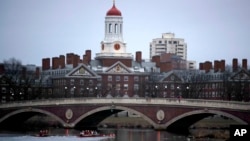
A federal judge in Boston heard closing arguments Friday in a highly publicized lawsuit alleging that elite Harvard discriminates against Asian-Americans.
Much of the spotlight has been on affluent Chinese-Americans with stellar academic scores who say the college rejects Asians in favor of lesser-qualified applicants. They say factoring in race hurts Asian-Americans.
But others in the Asian community say that a race-blind process relying solely on academic scores would also hurt Asian-Americans. Southeast Asians, for example, who largely came over as refugees from Vietnam, Laos and Cambodia, are underrepresented in higher education.
“The narrative right now is very focused on a very specific segment within the Asian-American community that does not represent the larger Asian-American community,’’ said Quyen Dinh, executive director of the Southeast Asia Resource Action Center.
The center signed on to a “friend of the court” brief by the Asian American Legal Defense and Education Fund, siding with Harvard’s use of what the university calls a “holistic’’ review of an applicant.
The case brought by Students for Fair Admissions could wind up before a newly reconstituted and more conservative U.S. Supreme Court, which only narrowly re-affirmed the use of race in college admissions two years ago.
Here are some of the issues surrounding Asian-Americans and affirmative action:
Who are Asian-Americans?
There are at least 18 million people in the U.S. who are of Asian descent from about 20 countries. Asian-Americans are about 6 percent of the U.S. population, but make up nearly 23 percent of this year’s freshman class at Harvard, 22 percent of the same class at Princeton, and are the fastest growing minority in the country.
Chinese-Americans are the largest sub-group with at least 4.3 million people, followed by Indian-Americans at 4 million and Filipino-Americans at 3 million.
Chinese started migrating to the country in the 19th century as labor for the growing West. More recent waves include refugees from Vietnam, Laos and Cambodia, as well as highly skilled workers from China and India.
The term “Asian-American” was coined by young civil rights activists marching alongside Latinos and African Americans for social justice in the 1960s.
Ellen D. Wu, a history professor and director of the Asian American Studies Program at Indiana University in Bloomington, says that political identity has now evolved largely into a demographic designation for “a very diverse group.’’
What is the Asian American Coalition for Education?
Students for Fair Admissions filed the lawsuit against Harvard in 2014. Actively supporting it is the Asian American Coalition for Education, which filed federal complaints in 2015 alleging discrimination. The coalition’s president is Yukong Zhao, a corporate strategist who immigrated to the U.S. from China in 1992 to pursue a master’s degree in business.
Zhao is part of a new generation of wealthier Chinese immigrants who are active on social media and opposed to affirmative action.
Conservative strategist Edward Blum, who is president of Students for Fair Admissions, was behind the last affirmative action admissions case, which accused the University of Texas of discriminating against white students. Blum lost that case at the U.S. Supreme Court.
Does affirmative action help or hurt Asian-Americans?
Depends on whom you ask.
Julie J. Park, author of “Race on Campus: Debunking Myths with Data” and past consultant to Harvard in the lawsuit, says underrepresented Asians such as Cambodians and Hmong can get a boost from a review that goes beyond test scores. The same goes for lower-income Asian-Americans whose grades may not reflect their potential. Park also says colleges want students with different backgrounds so Asian-Americans may be more coveted in fields or colleges with few Asians. It depends on the situation.
Students for Fair Admissions, on the other hand, argues the system in place at Harvard puts unfair weight on race, primarily at the expense of academically talented Asian-Americans. It also alleges that Harvard intentionally uses a vague “personal rating’’ to reject Asian-American applicants in favor of students from other racial backgrounds.
Supporters of affirmative action say it’s possible that Harvard is biased against Asian-Americans, but that doesn’t mean race-conscious policies should be scrapped.
Why are Asians called the ‘model minority’?
The stereotype of Asian-Americans as hard-working, educated and free of societal problems started in the 1960s. Wu, the history professor, says it was a way for whites to establish a racial order that was defined, most importantly, by not being black.
Asian-Americans were also responsible for perpetuating the myth, she said, adding that the “consequences of that have long functioned to justify anti-black racism and anti-black policies.”
Is there any truth to the model minority myth?
Overall, the numbers look good for Asian-Americans. Their household median income is $83,000, compared with $60,000 for the U.S. More than 50 percent have a bachelor’s degree or higher, compared with 32 percent for the country, according to the 2017 American Community Survey put out by the U.S. Census Bureau.
But there are large disparities within the group.
For example, while 75 percent of Indians held a bachelor’s degree or higher, only 16 percent of Laotians and 20 percent of Cambodians had done so. Among Chinese, the figure is 55 percent.
Indian households have the highest median income at $114,000 while at the other end are Burmese households, at $40,000. About 6 percent of Filipino individuals live in poverty, compared with 21 percent of Nepalese and 31 percent of Burmese.
See all News Updates of the Day
- By VOA News
Michigan State international students get their own space
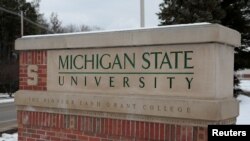
Michigan State University in East Lansing, Michigan, is setting aside a space in the International Center for international students.
Nidal Dajani, vice president of the school's International Student Association, said that the club plans to use the space to host events and hopes to collaborate with other student groups.
- By Dylan Ebs
International students find community during Pride Month
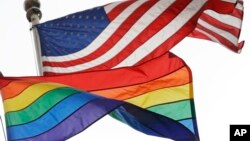
For LGBTQ+ international students, Pride Month, observed in June, is a unique time to reflect.
They hold on to multiple identities — both their LGBTQ+ identity and their cultural background — but coming to terms with them is not always easy.
For graduate student David Zhou, these identities can feel conflicting as transgender rights in China remain a controversial issue and spaces for LGBTQ people close. Zhou, 25, is transgender and pursuing an education in the STEM field at an urban university in the Midwestern United States.
VOA is using a pseudonym for Zhou’s first name and is not naming his university to protect his identity due to safety concerns back home in China. Zhou is not open about his transgender identity to his family.
During Pride Month, Zhou said he attended multiple LGBTQ+ events in his community and is surrounded by a supportive group of LGBTQ+ students who can relate to his experiences. But he’s not open about his identity to everyone on campus and said he doesn’t disclose his preferred pronouns to everyone to avoid transphobic comments.
“I feel like I have to make some judgments of the character of that person to see if they’re a good person to disclose [my identity] to,” Zhou said.
Zhou’s Pride Month celebrations included attending local markets with LGBTQ+ vendors and hanging out with his LGBTQ+ friends.
“They normalized being trans and for a long time I feel like trans identity is, should I say a vulnerability, brings me fear and worrying about discrimination, but having those events are helpful because it allowed me to see that queer people could just [live] openly,” he said.
At social events where few international students are present, Zhou said it can be tough to fit in.
“There's a lot of times like when they were talking about things I kind of, don't really understand, mostly because I kind of lack some background experience or knowledge,” he said.
Zhou said he is not aware of specific groups for LGBTQ+ international students at his university, but said international students are more prevalent in graduate programs and therefore find representation in organizations for LGBTQ+ graduate students.
In China, transgender individuals must obtain consent from an “immediate family member,” even for adults hoping to transition, which critics say limits the autonomy of transgender individuals while supporters say the policy protects doctors from violence by upset parents.
Struby Struble, a former coordinator of the University of Missouri LGBTQ+ Resource Center, told NAFSA: Association of International Educators in 2015 that LGBTQ+ international students face a “double barrier” on campus.
“With their international student friends, they feel isolated because they’re the LGBT one,” she said. “But then among the LGBT students on campus, they feel isolated because they’re the international one.”
Nick Martin, associate director of the Q Center, Binghamton University’s LGBTQ+ student support office, said when international students tour the center, there’s often a sense of hesitation as they enter a type of space that may not be present in their home country.
“I compare that to a year in after they've come into the space, they've again, maybe come to some of our events, they've got more connected,” he said.
Martin said graduate students have a unique interest in the Q Center as they may use the office for research and advocacy purposes that align with their studies.
“For older students, there may be hesitancy in a different way, but I think it's more in the vein of they want to do some of the advocacy work,” he said.
Martin said he thinks about how both his office and BU’s international student office can support students who come from countries with few — if any — protections for LGBTQ+ individuals.
“It's been a learning process of what those students really need, but I think I've kind of learned that a lot of students are just looking for the safe space that we offer,” Martin said.
- By VOA News
International students discuss US campus culture shock

International students at De Anza College in Cupertino, California, talked about culture shock in an article in La Voz News, the student newspaper.
"It felt like a major culture shock. Everything was so different, from academics to mannerism," said a student from Mexico.
Read the full story here.
These are the most expensive schools in the US

High tuition costs along with housing and food expenses can add up for students at U.S. colleges and universities.
MSNBC looked at the most expensive schools in the country, with one costing more than $500,000 for a bachelor’s degree. (June 2024)
Uzbekistan students admitted into top US universities
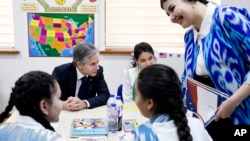
Students from Uzbekistan are among the international students admitted to top colleges and universities in recent years.
Gazata.uz profiled some of the Uzbekistan students attending Harvard, Brown, Princeton and other U.S. universities. (June 2024)




